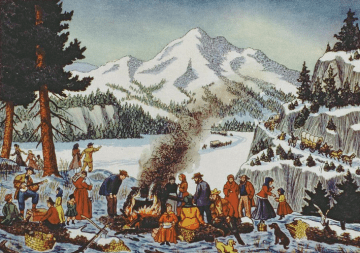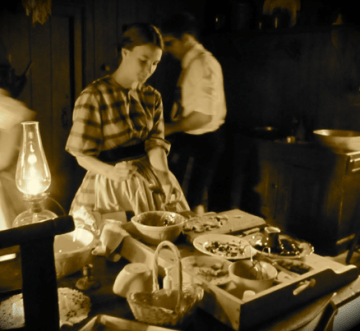An Early Bozeman Christmas
Kent Goodman | Wednesday Dec. 17th, 2014
The first Christmas to take place in the West occurred among thirty-two people in a crude log fort. There was a little whiskey, some buffalo and venison and a bit of dancing (a merry jig). Music was provided by a fiddle, trumpet, tambourine and harmonica. You might even recognize the names of the two commanders of this outfit – Lewis and Clark. The group was holed up for the winter in 1804 near a Mandan village in what was later Dakota.
Probably the first group to celebrate Christmas in Montana were in the Bitterroot Mountains, where a group of rugged trappers had gathered in Fort McMillan. They had shot a number of bighorn sheep, got in some tobacco and a hearty quantity of rum. A group of Flathead warriors were even allowed to join in the festivities.
Often in those early days, food was very scarce during the winter. Going days without food was a fairly common occurrence, and so the holiday season was anything but jolly. Many Christmases were spent nearly starving to death next to a small fire, longing for relatives left back “in the States.” The holiday rush was trying to find a deer to shoot before all hope was lost. However, it wasn’t always quite so desperate, since some of the forts stored supplies of liquor and tobacco for the season. The trappers in the area knew this, too, and would congregate in the forts and trading posts. For these solitary folks, this would be the one time during the year they would meet up, trade and exchange gossip. The whiskey would flow, and the feasts would always include plenty of wild game, especially buffalo and elk.
Once the party was liquored up, all hands would go outside the walls of the stockade and show off their shooting skills, because nothing spelled fun more than a bunch of drunken wild men with weapons. There would be festive dancing to the tune of a fiddle, and the Natives were usually in on the action, too. Although the tribes in the Rockies didn’t really have a mid-winter celebration, they were happy to join in the festival they called The Big Eating and would make sure to be in the neighborhood around December 25.
And so the season was celebrated in a sort of hit-or-miss affair, depending on the harshness of the times. The town of Bozeman was in the same boat. The town was really nothing more than a few shacks in the early years of the mid-1800s, situated on either side of muddy track, and it wasn’t until 1864 when anything was written about Christmas in the town. By that time, the town had gathered some steam and a grand ball was held in a new hotel that had been built on the corner of Main and Bozeman. And what did they do to celebrate? Naturally, the men got roaring drunk and held a shooting match. A few years later an even bigger ball was held. At these dances it was apparent that the men outnumbered the ladies by a huge amount, and so certain men had to take on the ladies’ roles. A person who was going to follow instead of lead would wear a handkerchief around his arm. Ooh-la-la!
Even when parties were held in homes, locally produced foods were the norm. To really show off, homeowners might have the ultimate luxury of canned oysters on hand. There were even accounts of Christmas trees in saloons being decorated with fried oysters. Forget the traditional turkey. They were only available to the richest men, since they went for $50 each. If a person wanted to toss money around, they could provide Salt Lake City eggs, bought for a small fortune. And a cake? Forget it. Flour was almost equal to gold. A sack would set you back $100, so much so that many towns, including Bozeman, suffered flour famines until they built their own mills.
In 1874 two Christmas celebrations were noted in the area; one in Bozeman and the other at Fort Benton. For the latter party, supplies of canned fruit, chewing and smoking tobacco, wild meat and (of course) plenty of whiskey were stockpiled. The men made a large amount of sourdough to go with the feast and thirty local Indians were invited.
Meanwhile, over in town, a party was held at T.B. Ellis’ house, because it was the largest. A big tree was brought in, which was a relatively new thing to do. Christmas trees were a German custom and only became popular after Prince Albert, Queen Victoria’s consort, brought one into Buckingham Palace in the 1840s. After that, everybody did it. Bozeman ladies were few and far between, but they invited all the bachelors to attend. However, there was one provision – the men had to wear white shirts, or, as they called them, “boiled shirts.” A number of fellows defiantly claimed they would never put them on, but by Christmas day, every boiled shirt in town had been purchased. By all accounts, it was a splendid party. The men even pooled their resources to buy toys for the poor children in town. For their part, the ladies gave each bachelor a black tie, along with tobacco or a handkerchief for those who didn’t smoke (there were men who didn’t smoke?!). 
Once the railroads came through, pretty much anyone could have a Victorian Christmas by ordering supplies from the large stores back East. Loneliness was no longer quite such a problem after the men brought their families out. The West was now right in line with the rest of the country.
On Christmas, when the latest computer-aided toy is unwrapped and we turn up the thermostat while we watch television specials, it can do us good to hearken back to the early years of Bozeman (not so very long ago). We can try to imagine a single farmer in the cold Gallatin Valley, sitting in front of the fire. He has a glass of whiskey in one hand, and perhaps a letter from his wife in the other. The winter, cold and snowy, is outside, at bay, for now.
And we can go even further back as we stare into the fire. Back before the Romans celebrated Saturnalia (a direct precursor to Christmas festivities), before the Druids and their holy mistletoe. All the way back to where Man first watched the stars, and made a crude attempt to bring back the longer days after the winter equinox on December 21st, perhaps by burning large fires and gathering together, telling stories and tales.
The beauty of this season is that we still have a direct link to our ancestors. We brighten our homes, inside and out, with lights against the darkness. We bring in greenery, Christmas trees and wreaths, to remind us of the Spring to come. We give charitably to those less fortunate, and honor and appreciate our friends and loved ones. And know that the spring thaw is only three, four…okay, six months away.
| Tweet |
